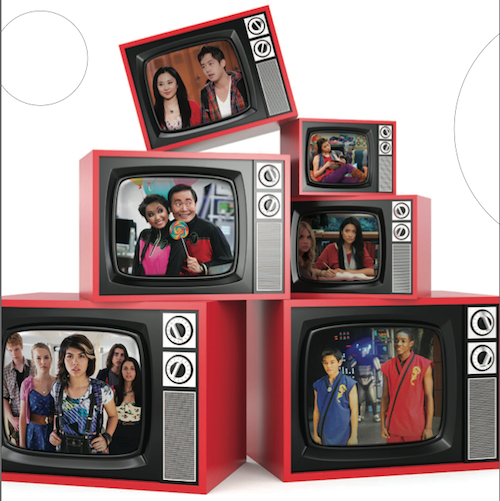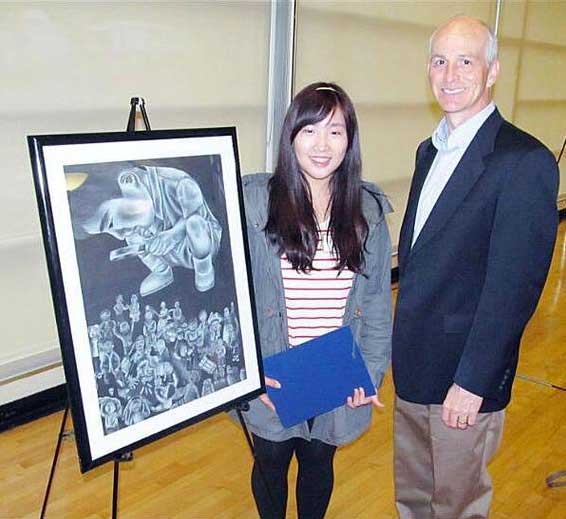Throughout the years, Asian Americans have yearned to see faces like theirs on the small screen. With Nickelodeon’s new show Supah Ninjas, the Asian American family is returning for the first time in 16 years as the star of a mainstream television series. While teen-oriented shows are saying they’re committed to diversity, do AA teens today really feel well-represented?
ISSUE: Spring 2011
DEPT: Features
STORY: Janice Jann
There’s a new family moving into TV-land this spring. The dad, a bumbling cop. The grandfather, a wise old man. And the son, a doe-eyed high-schooler named Mike who just wants to win over the girl of his dreams.
However, Mike is not just your average teen. He’s actually from a long line of ninjas who, along with his best friend and long-time crush, is being mentored by his grandfather’s spirit to kick butt and combat villains.
In fact, Supah Ninjas is not just your average show. The Nickelodeon series will be the only live-action series on American television centering around an Asian American star and family. Japanese-Caucasian Ryan Potter stars as Mike Fukanaga, “Hologramps” is played by the iconic Japanese American actor George Takei, and Korean American comedian Randall Park is the unassuming father. Even the talent behind the show, executive producers Leo Chu and Eric Garcia, are of Asian American descent.
This may not be television’s first or only foray into Asian American territory – Margaret Cho’s trailblazing All-American Girl croaked after only 19 episodes – but it took 16 long years for Hollywood to give an Asian American family another shot at a live-action scripted series.
Back in the ’80s, it was a rare occurrence to spot an Asian face on television. Carolina Yi, 31, doesn’t remember an Asian character, and Jacqueline Kim, 40, only recalls one who didn’t perpetuate a stereotype in a pantyhose commercial. “She didn’t act ethnic or anything,” says Kim. “That was the first time you saw a somewhat attractive Asian woman on TV.”
Back then, remembers Asian Pop columnist Jeff Yang, 43, “it was a common thing to do the Asian spotting [on TV] where you notice an Asian person – even in the background – and make a mental note.”
Thirty years later, things have shifted. Kim, Yi and Yang all have children of their own; the Asian Pacific Islander popu- lation has more than doubled, according to a 2010 Screen Actors Guild API Report; and teenagers watch an average of three hours of television a day.
The rise of cable television has brought a little more color to the small screen, especially in youth and teen programming, with both Nickelodeon and Disney Channel pioneers in embracing diversity. A 2008 article in The New York Times took note of this trend, stating that even though “prime-time network television is in a down cycle in roles for minority cast members, children’s television seems headed in the other direction.” In the story, Debra Martin Chase, who produced a movie for Disney Channel, stated, “One third of the U.S. population is now nonwhite. That is reflected in the Disney Channel projects because they are committed to diversity.”
Marjorie Cohn, executive vice president for development and original programming at Nickelodeon, echoed this sentiment in the same article. “Kids want to see themselves on TV,” said Cohn. “That is why diversity has always been a focus of ours and one of the exciting parts of how we develop shows. We want to reflect our audience.”
This mentality has resulted in some memorable Asian American characters on teen television: Hmong-Thai American Brenda Song’s ditzy heiress London Tipton on Disney Channel’s The Suite Life of Zack and Cody, Korean American Justin Chon’s wise-cracking Tony Lee on Nickelodeon’s Just Jordan; and Filipino American Shay Mitchell’s lesbian Emily on ABC Family’s Pretty Little Liars, to name a few.
We’re now, according to Yang, “at a point where we’re not about representation or inclusion, but whether the roles are rich, full, 3-D roles. We shouldn’t be counting heads or tallying faces anymore. We should be at a place where artists can be artists and where we can evaluate whether they entertain us.”
But have we reached a place where the roles out there for teen Asian American characters are rich, full and well-rounded?
“Lame.” “Nerdy.” “Geek.” “Fobby.” “Knows kung-fu.”
Those are just some of the words that Chinese American Howard Liu, 17, from Plano, Texas, uses to describe Asian American characters he sees on TV. “Never a jock,” says Liu. “Usually the one that is just there. Like a fill-in character.” Sixteen-year-old Indian American Bobby Adusumilli from Toledo, Ohio, adds that Asian American characters are “usually the ones that get made fun of.”
Liu and Adusumilli both say that such teen TV characters don’t really resemble them and that they actually relate more to the protagonists of these shows, none of which are portrayed by Asian Americans. “I have a good balance in my life,” says Adusumilli. “I take my schoolwork seriously, but I also work hard in sports.”
Perhaps it’s no wonder that youths are turning to an even smaller screen for representation: the computer.
“Many of the top stars on YouTube are Asian Americans that have a total viewership that would be enviable to television shows,” says Yang. “We’re talking tens of millions of people.” In fact, at press time, Japanese American comedian Ryan Higa’s channel, Nigahiga, is YouTube’s most subscribed channel with more than 3 million subscribers. Makeup guru Michelle Phan scored a Lancôme deal thanks to more than 24.8 million hits on her top video tutorial.
“When Asian Americans get the choice to see what they want, we see they’re choosing to watch more Asian faces,” says Phil Wang of the successful YouTube trio, Wong Fu Productions. “We have a choice in what we consume now and we choose to see faces like ours.”
Fourteen-year-old Iman Kazah, who is of Korean, Chinese and Arabic descent, agrees: “On YouTube there is more Asian representation. I’d rather watch [Wong Fu clips] than actual TV.”
YouTube and the Internet may satiate some Asian Americans’ desires to see more accurate portrayals of themselves onscreen, but mainstream media still has some catching up to do. In the SAG API report, 82 percent of all respondents said they strongly desired to see more visible API images in the media, and 87 percent agreed with this statement: “I feel a sense of pride in my culture when I see an actor of Asian Pacific Islander descent on television or in the cinema.”
It’s not just for us that Asian Americans need more representation on television; it’s good for society, too. “TV more affects [non-Asians] and their view of us than it affects us and how we see our identity,” says Kim, “because they have no idea what an Asian family is like other than a Chinese restaurant owner or whatever.” Adusumilli knows well the effects of the lack of representation. “People I don’t know will sometimes ask stupid questions or they would stereotype stupidly, like you’re going to be a doctor or a genius,” he says.
“The public tends to rely on characterizations from film and television to formulate beliefs about groups with whom they may be less familiar,” says Nancy Wang Yuen, assistant professor of Sociology at Biola University. “Representations of [Asian Americans] on television will impact the treatment and perceptions of [Asian Americans] in real life.”
Ironically, the most important perception may be that Asian Americans are just like everyone else. “I think of myself as an average person,” says Kim’s 14-year-old daughter, Evangeline, of Boston, Mass. “Whenever I see the regular schoolgirl just trying to make friends, I feel like I relate to them.”
Perhaps Supah Ninjas‘ Everyboy Mike will serve as that relatable character. If not a first step, perhaps the show will be a good next step. Sure, Mike’s a ninja, but producer Leo Chu warns viewers to recognize the difference between ethnic stereotyping and embracing rich cultural traditions. “We have our own heritage,” he says. “We can’t fall into the trap of thinking it’s normal not to see Asians as empowering Asian characters. No one else in the world, particularly in Asia, would ever think it’s a stereotype to see Asian ninjas. In fact, they would find it odd if ninjas weren’t Asian,” says Chu. “I don’t think anyone goes, ‘Oh, another white cowboy. How stereotypical!'”
Though media has made strides, at the end of the day, the dissatisfaction Asian American teens have with their representation on television is still attributed to their lack of face time. “There’s a lot more [Asians on TV], but still not enough to make young people feel like they’re incorporated in fictional society,” says Yuen. “All these characters on TV are going to be one-dimensional in some way. What I would fight for is more representation. As long as there’s more, there’s going to be less fixation on the few that is out there.”
– Janice Jann
More stories from Audrey Magazine’s Archives here.









